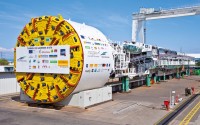Tunnels and Tunnelling: from Brunel to the future of underground space
- Date
- 17 Jan 2017
- Start time
- 7:30 PM
- Venue
- Tempest Anderson Hall
- Speaker
- Bill Grose

Tunnels and Tunnelling: from Brunel to the future of underground space
by Bill Grose, Chartered Civil Engineer and Tunnelling Consultant
A lecture in honour of Dennis A Martin
Part of a mini-series of lectures on Engineering in the 2017 lecture programme
This talk takes us from the early days of industrial revolution tunnelling to the intricacies of modern tunnel boring machines and techniques, and then into what the future might hold, exploring how tunnellers’ know-how developed from the early empirical methods to the appliance of science and now information technology and data management.
There are many uncertainties and dangers lurking underground and failures are frequently dramatic and sometimes fatal. Learning from failures has been a significant part of a tunneller’s education (although hopefully not their experience). The speaker will describe the forensic investigation of recent collapses across the world and key lessons learned.
Tunnels are often at the centre of socio-economic considerations, and sometimes controversy, on major infrastructure projects and we will look at why that is, and how resolution is reached (or not).
Finally we will look at the global trend of increasing use of underground space in general – sometimes for security or environmental control, but sometimes because societies are simply running out of space.
Member’s report
The UK tunnelling industry has been very successful, and relies heavily on both mechanical and civil engineers. Historically, tunnels have been used for security, mining, and major infrastructure such as roads, canals, and railways. Early pioneers were Thomas Telford and Marc Isambard Brunel, followed by PW Barlow and JH Greatland who invented tunnelling shields. Modern techniques include drill and blast; tunnel boring machines; and sprayed concrete lining machines. A tunnelling machine can be up to 18m in diameter, weigh 1000 tons, cost £15 to £20 million, and wears out very quickly, requiring continual improvement. Variants are “earth pressure balance machines” for harder rocks, and “slurry machines” for clay and chalk. The very complex ancillary equipment is dragged behind the machine, and the total power requirement can be as high as 14MW. It is even possible to operate in flooded tunnels under pressure. Sophisticated computer modelling and control is used for complex tunnels and stations, allowing very close approach to existing infrastructure.
Rod Leonard